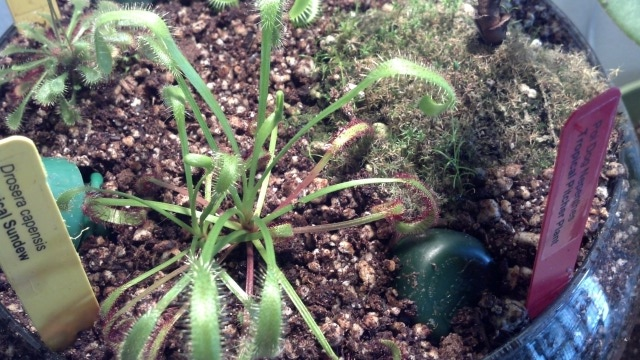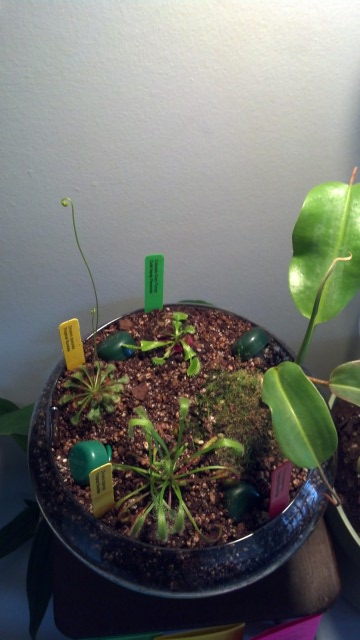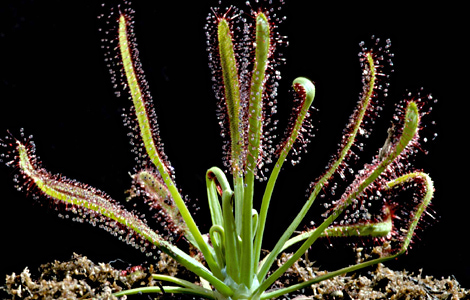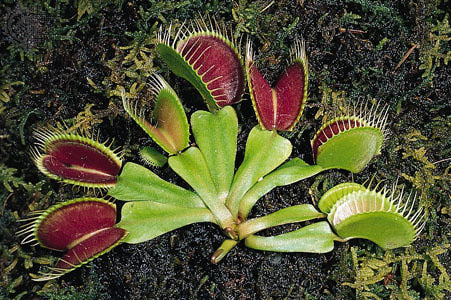Question capensis
capensis
 Plant set up
Plant set up
QUESTION: Hi there,
I bought four carnivorous plants from SNW early December, and I am absolutely pleased with their condition and vitality. I have all of them 18" away from a 65-Watt Plant light, timed for 8 hours of light daily, with distilled water. The temp inside is 70 F.
All plants are thriving and experiencing growth, even the plant in question. The D. capensis is growing (see attached pic). However, the leaves are flaccid and dew is excreted only from the sides, not on the top. They are curving downward and going towards the ground rather than towards the light source. Is this of concern and should I adjust anything in its environment?
The venus flytrap seen in the back-right of the picture is growing profusely, the most light-demanding plant in my small collection. Thus, I figured lack of light is not the main reason for the capensis wilting. Perhaps it is getting too much light?
Thank you so much for your time and advisement!
 Cape Sundew, Typical f
Cape Sundew, Typical f
 Venus Flytrap
Venus Flytrap
ANSWER: Hi Jonathan,
Let's start big picture, then work down to specifics of your plants. One big concept I consistently find that new cp growers struggle with is what the light needs of carnivorous plants really are, and what is meant by full-sun. Almost all of the bog species of carnivorous plants such as sundews, Venus Flytraps, Sarracenia Pitcher Plants are full-sun plants. In nature they have few trees in their habitats and are exposed to direct sun for most of the day. Examples of plants in gardens requiring full-sun would be most vegetables, tomatoes, annual and perennial flowers, berries and fruit trees. Replicating that with artificial light is often tricky. Our eyes are constantly adjusting, so what seems bright may not really be.
As you may have already figured out, lack of light is the issue with your plants. Your sundews and flytrap are showing classic signs of low light. When Cape Sundews curl under, have no color, and little to no dew, that is all because they don't have enough energy from photosynthesis to make proper leaves and mucilage. The D. spatulata produces large wide leaves that are pale green and dewless like you're seeing.
What you need to do is get them much closer to your light. You said it's a 65 watt plant light, but what kind of light is it? Compact fluorescent? Is it 65 actual watts, or 65 watt incandescent equivalent? Or, is it one of the incandescent "Spot Grow" bluish lights? Let me know, because it will make a difference in what you need to do. If it is a CFL, move your light to within 8 inches of the plants in the pot. Watch your plants for a couple weeks and see if they start getting some color. If you see red in new leaves (ignore anything that happens in the old leaves), and mucilage production, they you have it close enough. If they stay green, it needs to be closer; move to 6 inches away. If your light is an incandescent grow bulb, you'll need to change it to a CFL, minimum 23 actual watts. Incandescent bulbs are inappropriate for any kind of plant growing.
Your Nepenthes is probably fine being a little further away from the light, but if after a couple months you see no pitchers, it probably needs to be closer too. Also, is it planted with the sundews and flytrap in the same pot? If so, you'll need to get it out of there at some point since they need a very different soil media, and will develop root rot if kept as wet as the other plants like. Nepenthes are not bog plants.
Let's talk about your Venus Flytrap. Since you got your plants from us you may have noticed the color coding of the tags. They match up with the color of the care sheets since each group of plants have very specific needs in terms of temperature and growing conditions. Since this plant is green tagged, it's a North American native species, and a hardy perennial. To stay healthy they should be grown outdoors, and since you're in Alabama, your climate is totally appropriate for the plant. Lack of full sun in the summer, and lack of winter dormancy are the primary reasons people loose flytraps, and think Venus Flytraps are hard to grow. This is because everyone wants to keep them in the house. Plants that need both summer and winter don't do well indoors. I'd love to grow Strawberries in the house, but for the same reasons Strawberries don't do well indoors, Venus Flytraps don't do well indoors. In our nursery your flytrap had already been experiencing temperatures in the 20's and 30's. They were being kept in a cold-frame greenhouse that had the same temperatures as outside, or they were outside.
Now, having said all that, since you've had your plant in a warm house for over a month, it has broken it's dormancy, so it can't go back outside until spring. Just leave it where it is, get that light closer, then plan on potting it up separately and moving it outside in mid April. When you get a chance, be sure and review the care sheets that came with your plants. Many of the topics I'm covering here are in those. Here's a link to our care sheet pages on our website: http://www.growcarnivorousplants.com/Articles.asp?ID=256
Good Growing!
Jeff Dallas
Sarracenia Northwest
http://www.growcarnivorousplants.com
---------- FOLLOW-UP ----------
QUESTION: Thanks for the quick response, Jeff!
This is the exact plant light I am using: http://www.walmart.com/ip/GE-44603-GE-Plant-Light-Kit/16880994
It doesn't specify other than "plant light" but it does release some heat, which is why I kept is a little further away from the plants. Is there a bulb you recommend?
The Nepenthes grew another stalk and seems to be thickening in preparation for a pitcher. It is planted with the flytrap and sundews. I will separate them and use perlite/long-fiber sphagnum moss if you think it's best.
Thank you for your thorough responses and I look forward to solving the light-problem with my plants.
Jonathan
AnswerHi Jonathan,
Thanks for sending that link. As I suspected it is an incandescent bulb; these are the same as Sylvania "Spot-Gro". The only purpose this type of plant light, and I use the term super loosely, are good for is supplemental visual or decorative lighting. They are totally inappropriate for any type of plant growing carnivorous or otherwise. Traditional incandescent bulbs of any type, despite what they say about special phosphors, are way too lacking in blue and UV light for plant growth. You've seen the results.
Here's what you need. Replace the bulb in the fixture with a compact fluorescent bulb. You may have to fool around with what will fit, but you want the biggest one that will fit in the fixture. Here's an example of what you need: http://www.amazon.com/Feit-Electric-Fluorescent-Incandescent-Equivalent/dp/B000L You can buy these at just about any hardware store. Just be sure it's a "Daylight" (6,000-6500K color temperature) type bulb. If it's a full spectrum like Ott light or Agrosun, those are great too, they just cost a lot more. If a larger CFL than 23 watt will fit, use that.
Once you change it over give your plants about a month to recover. Adjust the height like a mentioned before since the CFL won't be nearly as hot.
Definitely transplant that Nepenthes, and consider moving that Flytrap outside in the spring.
You might also consider taking a look at our DVD series. These are designed to be hands-on guides that help avoid mistakes so common to first-time growers. The money spent on those will save you $$$$ in lost plants and in not purchasing the wrong materials. http://www.growcarnivorousplants.com/Grow-Carnivorous-Plants-DVDs-s/1826.htm
Good Growing!
Jeff Dallas
Sarracenia Northwest
http://www.growcarnivorousplants.com









